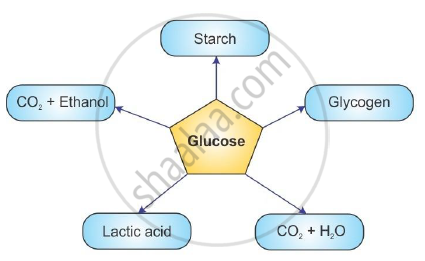Advertisements
Advertisements
Question
Answer in detail.
Explain the Kreb's cycle with reaction.
Solution

APPEARS IN
RELATED QUESTIONS
Given below are the end products of different reactions involving glucose. Write the appropriate end product in front of the following:

(1) Anaerobic reaction =
(2) Reaction in human muscles =
(3) Aerobic respiration
(4) Reaction in plant cells =
(5) Reaction in liver =
What criteria do we use to decide whether something is alive?
What are outside raw materials used for by an organism?
Which is the basic requirement of living organisms for obtaining energy?
Which of the following type of energy is used by living organisms to perform vital life processes? Kinetic energy, Chemical energy, Potential energy, Nuclear energy
Match the terms in column I with their uses in column II
| Column I | Column II |
| (i) Heart | (a) Pipes for transport in humans |
| (ii) Arteries and Veins | (b) Clotting of blood |
| (iii) Xylem vessels | (c) Pumping organ |
| (iv) RBC | (d) Water transport in plants |
| (v) Platelets | (e) Carrier of oxygen |
A person lives near a forest. Make a list of four items which he can get from the forest to meet his daily needs.
Name the green dot like structures in some cells observed by a student when a leaf peel was viewed under a microscope. What is this green colour due to?
Rewrite the food-chain given below with correct sequence.
Grasshopper– Snake– Paddyfield– Eagle– Frog
Fill in the blank and explain the statement.
Our muscle cells perform ______ type of respiration during exercise.
Write definition.
Nutrition.
Write definition
Nutrients
Write the definition.
Proteins
Write definition.
Glycolysis
Give scientific reason.
Oxygen is necessary for complete oxidation of glucose.
Explain the glycolysis in detail.
Answer in detail.
How all the life processes contribute to the growth and development of the body?
Explain the ‘inhalation’.
Soil fertility is determined by its ability to :
Name the organs that form the excretory system in human beings.
Find an odd one out.
What are the main energy sources of living organisms?
Assertion: When air is passed through lime water, lime water turns milky.
Reason: Air contains 78% nitrogen and 21% oxygen.
Choose the forms in which most plants absorb nitrogen
- Proteins
- Nitrates and Nitrites
- Urea
- Atmospheric nitrogen
Why do fishes die when taken out of water?
In each of the following situations what happens to the rate of photosynthesis?
- Cloudy days
- No rainfall in the area
- Good manuring in the area
- Stomata get blocked due to dust
Match the terms in Column (A) with those in Column (B)
| Column (A) | Group (B) |
| (a) Trypsin | (i) Pancreas |
| (b) Amylase | (ii) Liver |
| (c) Bile | (iii) Gastric glands |
| (d) Pepsin | (iv) Saliva |
Explain the following concept in short:
Balanced Diet
Explain the following concept in short:
Role of circulatory system in energy production
Give scientific reason.
Cell division is one of the important properties of cells and organisms.
Classify vitamins according to their solubility.
